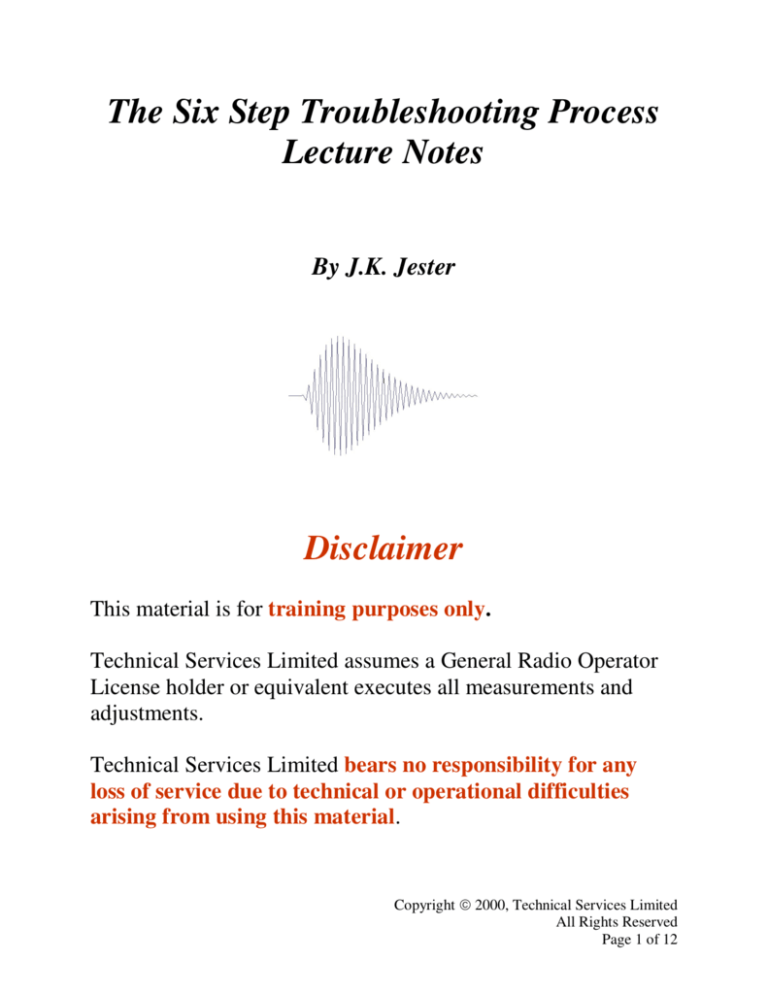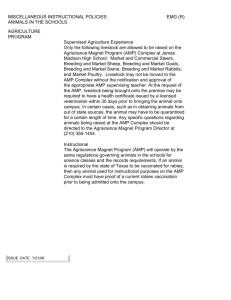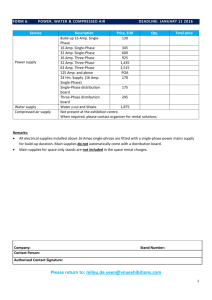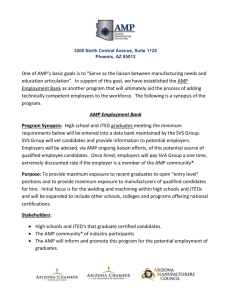
The Six Step Troubleshooting Process
Lecture Notes
By J.K. Jester
Disclaimer
This material is for training purposes only.
Technical Services Limited assumes a General Radio Operator
License holder or equivalent executes all measurements and
adjustments.
Technical Services Limited bears no responsibility for any
loss of service due to technical or operational difficulties
arising from using this material.
Copyright
2000, Technical Services Limited
All Rights Reserved
Page 1 of 12
The six-step troubleshooting process
STEP 1
STEP 2
STEP 3
STEP 4
STEP 5
STEP 6
SYMPTOM
RECOGNITION
SYMPTOM
ELABORATION
LISTING
OF
PROBABLY
FAULTY
FUNCTION
LOCALIZING
THE
FAULTY
FUNCTION
LOCALIZING
TROUBLE
TO
THE
CIRCUIT
FAILURE
ANALYSIS
SENSES
KNOWLEDGE
SENSES
KNOWLEDGE
OPERATIONAL
CONTROLS
NOTES
SENSES
KNOWLEDGE
NOTES
DIAGRAMS
SENSES
KNOWLEDGE
NOTES
DIAGRAMS
TESTING DEVICES
SENSES
KNOWLEDGE
NOTES
DIAGRAMS
TESTING DEVICES
SENSES
KNOWLEDGE
NOTES
DIAGRAMS
TESTING DEVICES
REVIEW
The technician's toolbox
Six-Step Troubleshooting Process
During your career as an electronic technician; you will maintain or help maintain some electrical or electronic
system, subsystem, or unit. These tasks seem complex, but even complex tasks can be broken down into simpler
ones. The key is breaking down a complex system into functional systems. Any repair should follow the steps of the
six-step troubleshooting process. We will execute these steps on a VHF radio to illustrate this process.
In our example, the work order states no one could hear the operator but the operator could hear everyone else on
the VHF radio. You take the radio to your workbench and set it up to verify the complaint.
Copyright
2000, Technical Services Limited
All Rights Reserved
Page 2 of 12
Step 1. Symptom recognition. This is recognizing some disorder or malfunction in the system.
In the technician’s toolbox, you have your:
• senses [sight, sound, smell, touch, and taste]
• knowledge
Former UCLA Coach John Wooden once said, Failure to prepare is preparing to fail. You must prepare your
intellectual asset through constant review of technical materials. Your intellectual asset, knowledge, combined with
the input from your senses allows you to ascertain whether the system is operating within general specifications.
You do not use all five senses in the troubleshooting process. You do not touch or taste energized circuits.
A two-way radio has these functions:
•
•
•
transmits intelligible audio on a specified frequency
receives intelligible audio on a specified frequency
selects the channel and displays the channel number
Problems can be a complete failure in any functions or degraded performance in one or more of the functions.
Checking the basic functions will eliminate those that appear to be working. If all functions appear to be working,
then execute a detailed functional check.
Step 2. Symptom elaboration. We obtain a detailed description of the trouble in the system during this step.
In the technician’s toolbox you have:
• your senses [sight, sound, smell, touch, and taste]
• your knowledge
• your observations when manipulating the operational controls
• your notes
Remember this Chinese proverb: The faintest ink is brighter than the brightest mind.
After setting up the test equipment, measure and record the results from these tests:
When transmitting measure and record:
• Transmitter Power
• Transmitter Frequency
• Frequency deviation when speaking into the microphone
• Frequency deviation w/o speaking into the microphone
When receiving measure and record:
• Receiver sensitivity w/CTCSS
• Receiver sensitivity w/o CTCSS if the test above fails
Change Channels and repeat above tests
The Results of the test were:
• Transmitter Power
• Transmitter Frequency
• Frequency deviation when speaking into the microphone
• Frequency deviation w/o speaking into the microphone
• Receiver sensitivity w/CTCSS
• Receiver sensitivity w/o CTCSS if the test above fails
• Change Channels and retested above
Copyright
PASSED
PASSED
FAILED
PASSED
PASSED
------ NOT RUN
Similar results
2000, Technical Services Limited
All Rights Reserved
Page 3 of 12
Step 3. Listing probable faulty functions. During this step, we break down a complex system into simpler
functions. We answer the question, which function works and which doesn’t. From this functional analysis, we
logically conclude, which functions can be eliminated as the cause of the symptoms. The remaining functions will
be scrutinized during the troubleshooting process.
In the technician’s toolbox you have:
• your senses [sight, sound, smell, touch, and taste]
• your knowledge
• your notes
• equipment diagrams
This is the first step we view an equipment diagram; either on paper or in our head. Experienced technicians have
mental images of the functional diagrams. View the functional diagram to determine what we can eliminate as the
cause of the failure in the previous step’s tests:
R
XMTR
OSC
BUFFER
PHASE
MODULATOR
x2 x2 x3
MULTIPLIERS
DRIVER
POWER
AMPLIFIER
LP
FILTER
POWER
CONTROL
T
PREEMPHASIS
CTCSS
RECEIVER
TRANSMITTER
AF
AMP
AF
AMP
AF
AMP
AF
AMP
+12 V
PTT
Copyright
2000, Technical Services Limited
All Rights Reserved
Page 4 of 12
Transmitter Tests
•
Transmitter Power : PASSED : Eliminated the Driver, Power Amplifier, LP Filter, Power Control,
Antenna Relay, and Output Jack.
R
XMTR
OSC
PHASE
MODULATOR
BUFFER
x2 x2 x3
MULTIPLIERS
DRIVER
POWER
AMPLIFIER
LP
FILTER
POWER
CONTROL
T
PREEMPHASIS
CTCSS
RECEIVER
TRANSMITTER
AF
AMP
AF
AMP
AF
AMP
AF
AMP
+12 V
PTT
•
Transmitter Frequency : PASSED : Eliminated OSC, Buffer, and Multipliers. Partially eliminated
the Phase Modulator.
R
XMTR
OSC
BUFFER
PHASE
MODULATOR
x2 x2 x3
MULTIPLIERS
DRIVER
POWER
AMPLIFIER
LP
FILTER
POWER
CONTROL
T
PREEMPHASIS
CTCSS
RECEIVER
TRANSMITTER
AF
AMP
AF
AMP
AF
AMP
AF
AMP
+12 V
PTT
Copyright
2000, Technical Services Limited
All Rights Reserved
Page 5 of 12
•
Frequency deviation when speaking into the microphone: FAILED : Nothing new is eliminated
R
XMTR
OSC
PHASE
MODULATOR
BUFFER
x2 x2 x3
MULTIPLIERS
DRIVER
POWER
AMPLIFIER
LP
FILTER
POWER
CONTROL
T
PREEMPHASIS
CTCSS
RECEIVER
TRANSMITTER
AF
AMP
AF
AMP
AF
AMP
AF
AMP
+12 V
PTT
•
Frequency deviation w/o speaking into the microphone : PASSED : Eliminated CTCSS, 3rd and
4th AF Amplifier, Pre-Emphasis, and the Phase Modulator
R
XMTR
OSC
BUFFER
PHASE
MODULATOR
x2 x2 x3
MULTIPLIERS
DRIVER
POWER
AMPLIFIER
LP
FILTER
POWER
CONTROL
T
PREEMPHASIS
CTCSS
RECEIVER
TRANSMITTER
AF
AMP
AF
AMP
AF
AMP
AF
AMP
+12 V
PTT
Receiver
•
•
Receiver sensitivity w/CTCSS : PASSED : Eliminated Receiver Section
Receiver sensitivity w/o CTCSS if the test above fails : Same circuits were covered by the
w/CTCSS test.
Channel
•
Change Channels and repeat the transmitter and receiver measurements. : PASSED : Eliminated
Frequency Synthesizer.
Copyright
2000, Technical Services Limited
All Rights Reserved
Page 6 of 12
Step 4. Localizing the faulty function. During this step, we eliminate the working functions in our list developed in
Step 3. We will use signal tracing to determine which function or functions are actually at fault.
In the technician’s toolbox you have:
• your senses [sight, sound, smell, touch, and taste]
• your knowledge
• your notes
• equipment diagrams
• testing devices
This is the first step using testing devices. Testing devices include multi meter, capacitor checker, inductor checker,
transistor checker, oscilloscope, etc . . . Use the technical manual schematic for the remaining steps.
Functionally we are concentrating the troubleshooting in the microphone, the 1st AF Amp, and the 2nd AF Amp.
Those three areas directly relate to the failed test.
R
XMTR
OSC
PHASE
MODULATOR
BUFFER
x2 x2 x3
MULTIPLIERS
POWER
AMPLIFIER
DRIVER
LP
FILTER
POWER
CONTROL
T
PREEMPHASIS
CTCSS
RECEIVER
TRANSMITTER
AF
AMP
AF
AMP
AF
AMP
AF
AMP
+12 V
PTT
We look at the schematic and see what we have eliminated in the audio section. We have eliminated all after the
CTCSS injection point. We place our right hand bracket at that point. Place the left hand bracket at the known
defective point, the microphone input. Inject an audio signal [ 1 kHz ] into the microphone input and key the
transmitter so we can signal trace the signal. Verify the loss of the 1 kHz signal at the junction of R507 and R510
and place the right hand bracket at that point.
CTCSS
C504
0.2 uF
R561
10 k
R509
15 k
R503
470 k
U1
C501
150 pF
G
C502
0.015 uF
20
21
C501
150 pF
R502
36 k
-
R508
22 k
R505
330 k
R504
30 k
C503
0.022 uF
R507
22 k
-
+
R510
4.7 k
+
R506
4.7 k
R515
15 k
C506
4700 pF
-
C510
1000 pF
R513
22 k
+
C505
0.015 uF
C509
0.015 uF
R514
12 k
+
R516
10 k
C511
0.2 uF
R511
2.7 k
2%
C508
10 uF
Copyright
2000, Technical Services Limited
All Rights Reserved
Page 7 of 12
Step 5. Localizing trouble to the circuit. Once we determine which function is at fault, we can use signal tracing or
signal injection to localize the problem to a circuit. Either signal tracing or signal injection is acceptable and you
will use the half-split method to quickly determine the faulty circuit.
In the technician’s toolbox you have:
• your senses [sight, sound, smell, touch, and taste]
• your knowledge
• your notes
• equipment diagrams
• testing devices
Our next step is to eliminate the maximum number of circuits. We use the half-split method and signal tracing.
CTCSS
C504
0.2 uF
R561
10 k
R509
15 k
R503
470 k
U1
C501
150 pF
G
C502
0.015 uF
20
21
R502
36 k
-
R505
330 k
R504
30 k
R507
22 k
-
R510
4.7 k
+
R506
4.7 k
Half-Split
Test Point
R515
15 k
C506
4700 pF
C503
0.022 uF
+
C501
150 pF
R508
22 k
-
C510
1000 pF
R513
22 k
+
C505
0.015 uF
C509
0.015 uF
R514
12 k
+
R516
10 k
C511
0.2 uF
R511
2.7 k
2%
C508
10 uF
Half-splitting the circuit has us testing for a 1 kHz signal at the output of the 1st AF Amplifier. A 1 kHz signal at
that test point indicates all the circuits that precede the test point are operating normally and the microphone is
probably good. We eliminated the 1st AF Amplifier circuits and possibly the microphone. We have narrowed down
the problem to somewhere after the test point (output of the 1st AF Amplifier) and before the CTCSS injection point
into the 3rd AF Amplifier. We have bracketed the problem to one function, the 2nd AF Amplifier.
CTCSS
C504
0.2 uF
R561
10 k
R503
470 k
R502
36 k
+
R508
22 k
R505
330 k
R504
30 k
C503
0.022 uF
R507
22 k
+
R506
4.7 k
Copyright
C505
0.015 uF
2000, Technical Services Limited
All Rights Reserved
Page 8 of 12
Half-split the circuit. We move the left bracket to the known good point at the output of the 1st AF Amplifier.
Half-splitting the brackets eliminates the maximum number of components. The half-split test point becomes the
input of the 2nd AF Amplifier.
CTCSS
C504
0.2 uF
R561
10 k
R503
470 k
R502
36 k
R505
330 k
R504
30 k
-
R508
22 k
C503
0.022 uF
R507
22 k
-
+
+
R506
4.7 k
Half-Split
Test Point
C505
0.015 uF
This test fails, so move the right bracket to this point. Half-split the circuit. The test point becomes the junction of
R504 and C503.
CTCSS
C504
0.2 uF
R561
10 k
R503
470 k
R502
36 k
-
R508
22 k
R505
330 k
R504
30 k
+
C503
0.022 uF
R507
22 k
+
R506
4.7 k
Half-Split
Test Point
Copyright
C505
0.015 uF
2000, Technical Services Limited
All Rights Reserved
Page 9 of 12
The test passes. Move the left bracket to this test point.
CTCSS
C504
0.2 uF
R561
10 k
R503
470 k
R502
36 k
+
R508
22 k
R505
330 k
R504
30 k
C503
0.022 uF
R507
22 k
+
R506
4.7 k
C505
0.015 uF
We can not half-split any more. The defective component is within the brackets, or loading the device within the
brackets. Use a multi meter to ensure the voltages are proper within the circuit. Use a capacitance checker to ensure
the capacitor is within tolerance and the ESR is within specifications.
Copyright
2000, Technical Services Limited
All Rights Reserved
Page 10 of 12
6. Failure analysis. The final step.
In the technician’s toolbox you have:
• your senses [sight, sound, smell, touch, and taste]
• your knowledge
• your notes
• equipment diagrams
• testing devices
• your review
This step has multiple tasks:
•
•
•
•
•
You renew the faulty part
You determine what caused the failure
You restore the equipment to the minimum operating specifications
You update the maintenance logs
You update the reorder parts list to replenish the stock.
After you replaced C503, the open capacitor, execute the same basic test that failed step 1 to verify the repair.
The maintenance record includes the following:
•
•
•
•
•
Technician
Date of Failure
Model
Symptoms
Solutions
A maintenance record develops the history of the equipment and is very useful.
Common symptoms resulting in the same faulty part reveals potential problems in the component parameters. The
problem could be caused by an improper procedure resulting in the application of excessive signals to the
component. An Engineering Change Order would recommend changing the component to a higher value or change
the procedure to ensure the proper signal level is applied to the component.
Sometimes you may run into difficulty troubleshooting the problem. This usually results from a misunderstanding
during an early step in the process. Some hints to help your efforts are:
•
•
•
Observe the equipment'
s operation for any and all faults
Check for any defective components with your eyes and nose
Analyze the cause of the failure for a possible underlying problem
Copyright
2000, Technical Services Limited
All Rights Reserved
Page 11 of 12
The six-step troubleshooting process
STEP 1
STEP 2
STEP 3
STEP 4
STEP 5
STEP 6
SYMPTOM
RECOGNITION
SYMPTOM
ELABORATION
LISTING
OF
PROBABLY
FAULTY
FUNCTION
LOCALIZING
THE
FAULTY
FUNCTION
LOCALIZING
TROUBLE
TO
THE
CIRCUIT
FAILURE
ANALYSIS
SENSES
KNOWLEDGE
SENSES
KNOWLEDGE
OPERATIONAL
CONTROLS
NOTES
SENSES
KNOWLEDGE
NOTES
DIAGRAMS
SENSES
KNOWLEDGE
NOTES
DIAGRAMS
TESTING DEVICES
SENSES
KNOWLEDGE
NOTES
DIAGRAMS
TESTING DEVICES
SENSES
KNOWLEDGE
NOTES
DIAGRAMS
TESTING DEVICES
REVIEW
The technician's toolbox
Copyright
2000, Technical Services Limited
All Rights Reserved
Page 12 of 12








